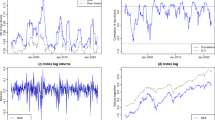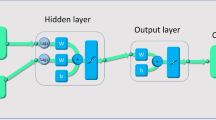Abstract
This study presents evidence of an asymmetrical quadratic effect from financial asset return on volatility. The relationships between the two variables are quadratic for both positive and negative returns and systematically different in the two regimes. The convex relations are observed showing that extreme shocks have a diminishing marginal impact on volatility. A threshold quadratic model under GARCH framework is developed to capture the effect and applied to major stock indices. The empirical outcomes of quadratic regressions and in-sample estimations significantly confirm the asymmetrical quadratic behavior. With application of S&P500 series, both diagnoses of in-sample estimations and evaluations of out-of-sample forecasts verify the proposed specification as a valid alternative volatility modeling.
Similar content being viewed by others
References
Andersen T. G. (1994) Stochastic autoregressive volatility: A framework for volatility modeling. Mathematical Finance 4: 75–102
Baillie R. T., Bollerslev T., Mikkelsen H. O. (1996) Fractionally integrated generalized autoregressive conditional heteroscedasticity. Journal of Econometrics 74: 3–30
Bakshi G., Ju N., Ou-Yang H. (2006) Estimation of continuous-time models with an application to equity volatility dynamics. Journal of Financial Economics 82: 227–249
Bauwens L., Laurent S., Rombouts J. (2006) Multivariate GARCH models: A survey. Journal of Applied Econometrics 21: 79–109
Bekaert G., Wu G. (2000) Asymmetric volatility and risk in equity markets. Review of Financial Studies 13: 1–42
Berkes I., Horvath L., Kokoszka P. (2003) GARCH processes: Structure and estimation. Bernoulli 9: 201–227
Blair B., Poon S., Taylor S. J. (2001) Forecasting S&P100 volatility: The incremental information content of implied volatilities and high frequency index returns. Journal of Econometrics 105: 5–26
Bollerslev T. (1986) Generalized autoregressive conditional heteroscedasticity. Journal of Econometrics 31: 307–328
Bollerslev T. (1987) A conditionally heteroskedastic time series model for speculative prices and rates of return. Review of Economics and Statistics 69: 542–547
Bollerslev T., Ghysels E. (1996) Periodic autoregressive conditional heteroscedasticity. Journal of Business and Economic Statistics 14: 139–151
Bollerslev T., Chou R. Y., Kroner K. F. (1992) ARCH modeling in finance: A review of the theory and empirical evidences. Journal of Econometrics 52: 5–59
Carnero M. A., Peña D., Ruiz E. (2007) Effects of outliers on the identification and estimation of the GARCH models. Journal of Time Series Analysis 28: 471–497
Charles A. (2008) Forecasting volatility with outliers in GARCH models. Journal of Forecasting 27: 551–565
Chiarella C., To T.-D. (2006) The multifactor nature of the volatility of futures markets. Computational Economics 27: 163–183
Enders W. (2004) Applied econometric time series. Wiley Series in Probability and Statistics. Wiley, New York, NY
Engle R. F. (1982) Autoregressive conditional heteroskedasticity with estimates of the variance of UK inflation. Econometrica 50: 987–1008
Engle R. F., Bollerslev T. (1986) Modelling the persistence of conditional variance. Econometric Review 5: 1–50
Engle R. F., Ng V. K. (1993) Measuring and testing the impact of news on volatility. Journal of Finance 48: 1749–1778
Eraker B., Johannes M., Polson N. (2003) The impact of jumps in volatility and returns. Journal of Finance 58: 1269–1300
Fama E. F. (1965) The behavior of stock market prices. Journal of Business 38: 34–105
Francq C., Zakoian J. M. (2004) Maximum likelihood estimation of pure GARCH and ARMA-GARCH processes. Bernoulli 10: 605–637
Franses P. H., van Dijk D. (1996) Forecasting stock market volatility using (non-linear) GARCH models. Journal of Forecasting 15: 229–235
Gilli M., Kellezi E. (2006) An application of extreme value theory for measuring financial risk. Computational Economics 27: 207–228
Glosten L. R., Jagannathan R., Runkle D. E. (1993) On the relation between the expected value and the volatility of the normal excess return on stocks. Journal of Finance 48: 1779–1801
Haas M., Mittnik S., Paolella M. S. (2004) A new approach to Markov-switching GARCH models. Journal of Financial Econometrics 2: 493–530
Hsieh D. (1989) Modeling heteroskedasticity in daily foreign exchange rates. Journal of Business and Economic Statistics 7: 307–317
Laurent S. (2004) Analytical derivatives of the APARCH model. Computational Economics 24: 51–57
Ling S., McAleer M. (2002) Stationarity and the existence of moments of a family of GARCH processes. Journal of Econometrics 106: 109–117
Lopez J. (2001) Evaluating the predictive accuracy of volatility models. Journal of Forecasting 20: 87–109
Nelson D. B. (1991) Conditional heteroskedasticity in asset returns: A new approach. Econometrica 59: 347–370
Rabemananjara R., Zakoian J. M. (1993) Threshold ARCH models and asymmetries in volatility. Journal of Applied Econometrics 8: 31–49
Ramsey J. B. (1969) Tests for specification errors in classical linear least-squares analysis. Journal of the Royal Statistical Association (Series B) 71: 350–371
Sentana E. (1995) Quadratic ARCH models. Review of Economic Studies 62: 639–661
Thiel H. (1966) Applied economic forecasting. Rand McNally, Chicago, IL
van Dijk D., Franses P. H., Lucas A. (2002) Testing for ARCH in the presence of additive outliers. Journal of Applied Econometrics 14: 539–562
Yu J. (2005) On leverage in a stochastic volatility model. Journal of Econometrics 127: 165–178
Zakoian J. M. (1994) Threshold heteroscedastic models. Journal of Economic Dynamics and Control 18: 931–995
Author information
Authors and Affiliations
Corresponding author
Rights and permissions
About this article
Cite this article
Huang, A.Y. Volatility Modeling by Asymmetrical Quadratic Effect with Diminishing Marginal Impact. Comput Econ 37, 301–330 (2011). https://doi.org/10.1007/s10614-011-9254-2
Accepted:
Published:
Issue Date:
DOI: https://doi.org/10.1007/s10614-011-9254-2




